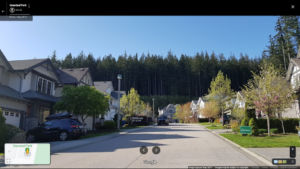Port Moody, British Columbia, Canada
March 4, 2023 By: Jason Senna
Location: Cliffwood Drive, Port Moody, BC, Canada

The city I am from is Port Moody, British Columbia, Canada, which has a land area of 26.21 square kilometers, and its population in 2021 sat at 33,535 residents.[1] Port Moody contains multiple lakes, a mountain, a famous inlet, several parks, and 41 creeks and streams. Port Moody uses the Official Community Plan for choices on development, scheduling and land use supervision, which is also influenced by observations from stakeholders, council, city staff, and residents.[2] Port Moody employs several bylaws to regulate how constructions and land are utilized and exploited.[2] Port Moody has development licensing procedures to ensure the care of environmentally sensitive areas[3] and promotes nature scaping to assist waterways, sewers, and wildlife habitation on public and private property.[4] The Port Moody Ecological Society consists of volunteers and has taught environmental stewardship and awareness for three decades through training and programs.[5] Port Moody’s Stream Stewardship Program ensures the well-being of streamside vegetation, watersheds, and waterways, which foster the population of fish and insects vital to the sustainability of Port Moody’s ecosystem.[6] Port Moody prohibits the use of pesticides and annually arranges seminars for its citizens to comprehend how to garden naturally.[6] Port Moody’s Climate Action Plan asserts the importance of mitigation which looks to reduce greenhouse gas emissions, and adaptation procedures, which assist residents in adapting to the dangerous concerns caused by climate change.[7] Acknowledging and incorporating these methods of combatting and managing climate change “at all levels of policy, planning and practice will transition Port Moody toward a more energy efficient, resilient, and sustainable future” as its citizens and staff aim will be wholly united.[7]
Invasive species within the city of Port Moody include Canada Thistle (Cirsium arvense), English Holly (Ilex auifolium), English Ivy (Hedera helix), Giant Hogweed (Heracleum mantegazzianum), Himalayan Blackberry (Rubus discolor), Japanese Knotweed, Orange Hawkweed (Hieracium aurantiacum), Policeman’s Helmet (Impatiens glandulifera), Purple Loosestrife (Lythrum salicaria), Reed Canary Grass (Phalaris arundinacea), Saltmeadow Cordgrass (Spartina patens), Scotch Broom (Cytisus scoparius), Yellow Flag Iris (Iris pseudacorus), Yellow Lamium (Lamium galeobdolon).[8] Wildlife apparent in Port Moody includes the Little Brown Bat (Myotis lucifugus), the North American Beaver (Castor canadensis), the American Black Bear (Ursus americanus), the Canada Goose (Branta canadensis), the Cougar (Puma concolor), the Coyote (Canis latrans), the Harbor Seal (Phoca vitulina)[9], the Chinook (Oncorhynchus tshawytscha), the Chum (Oncorhynchus keta), and the Coho (Oncorhynchus kisutch) Salmon along with 52 other fish species.[10]
Port Moody’s early visitors included Royal Engineers who were instructed to establish a trail (now known as North Road) travelling from New Westminster to the Burrard Inlet in the mid-19th century.[11] This trail would be a means of transporting military members and equipment to New Westminster from vessels in the Burrard Inlet if the then capital of British Columbia demanded improved protection.[11] In the late 19th century, Port Moody was anticipating becoming the principal town in western Canada after it was titled the west terminus of the Canadian Pacific Railway (CPR) and was Canada’s link to the silk trade in the distant east.[11] Port Moody is where passengers aboard the first transcontinental crossing of a train that carried travellers in Canada arrived. However, William Van Horne (former president of the CPR) determined that Port Moody was inadequate to be the furthest west terminus.[11] Therefore, it expanded to the then-new city of Vancouver because administrators agreed that Port Moody lacked land for construction and development, which a chief CPR terminus necessitated.[11] Before several Royal Engineers settled in Port Moody because they were given land grants after the completion of the CPR, Port Moody was not much of anything other than small groupings of huts and tents with few inhabitants.[11] It is known through reports that First Nations groups trekked to the area of contemporary Port Moody and inhabited there to hunt and collect shellfish in abundance to last the upcoming winter.[11] Plentiful evidence along Port Moody’s shoreline confirms that Coast Salish peoples occupied Port Moody before European contact.[12]
The Pacific Coast Terminals receive ethylene glycol and sulphur and stock it until it is loaded onto vessels and distributed worldwide.[13] It is one of the biggest sulphur export terminals in the world, making it crucial and beneficial to Port Moody’s economy and a central terminal in the Port of Vancouver that connects western Canada to Asian markets.[13] The Imperial Oil plant in Port Moody opened in 1915 and functions as a gas distribution terminal.[13] It globally distributes “marine gas oil, diesel flux, intermediate fuels, and bunker fuels” in bulk via vessels that take the sea and is one of Canada’s leading corporations.[13] Flavelle Sawmill Company Ltd. used to have a lumber mill in Port Moody but closed after 115 years to construct condos included in a new oceanfront development.[13] The Burrard Generating Station was a 900-megawatt natural gas-fired generating plant decommissioned in 2016.[13] Still, it was fundamental for decades in the progression of Port Moody becoming the city it is today.[13] “It was BC Hydro’s sole conventional steam-electrical thermal plant and powered about 700,000 homes.”[13] The Suncor Energy Burrard Products Terminal obtains and stocks refined transportation fuel and prepares “conventional gasoline, oxygenated gasoline, ultra-low sulphur diesel, biodiesel, and jet fuel” to sell on the marketplace.[13] The Reichhold Industries facility in Port Moody was open for about four decades and “manufactures alkyd/urethane coating resins, polyester resins, and latex emulsion resins.”[13] The stiff plastics industry expends polyesters, while the coating resins are inserted within coatings and paints that are commercially sold.[13]
(1) https://www.portmoody.ca/en/business-and-development/economic-development.aspx
(2) https://www.portmoody.ca/en/business-and-development/development-and-planning.aspx#Heritage-protection
(3) https://www.portmoody.ca/en/recreation-parks-and-environment/environment.aspx
(4) https://stewardshipcentrebc.ca/scbc-case-studies/naturescape-british-columbia/
(5) https://www.noonscreek.org
(6) https://en.wikipedia.org/wiki/Port_Moody
(7) https://www.portmoody.ca/en/city-hall/climate-action-plan.aspx#Implementation-annual-reports
(8) https://www.portmoody.ca/en/home-and-property/invasive-plants.aspx
(9) https://www.portmoody.ca/en/recreation-parks-and-environment/wildlife.aspx
(10) https://vcn.bc.ca/pmes/Port%20Moody%20Arm.htm
(11) https://www.portmoody.ca/en/arts-culture-and-heritage/port-moody_s-history.aspx
(12) https://www.thecanadianencyclopedia.ca/en/article/port-moody
(13) https://www.portmoody.ca/en/business-and-development/industry-profile.aspx